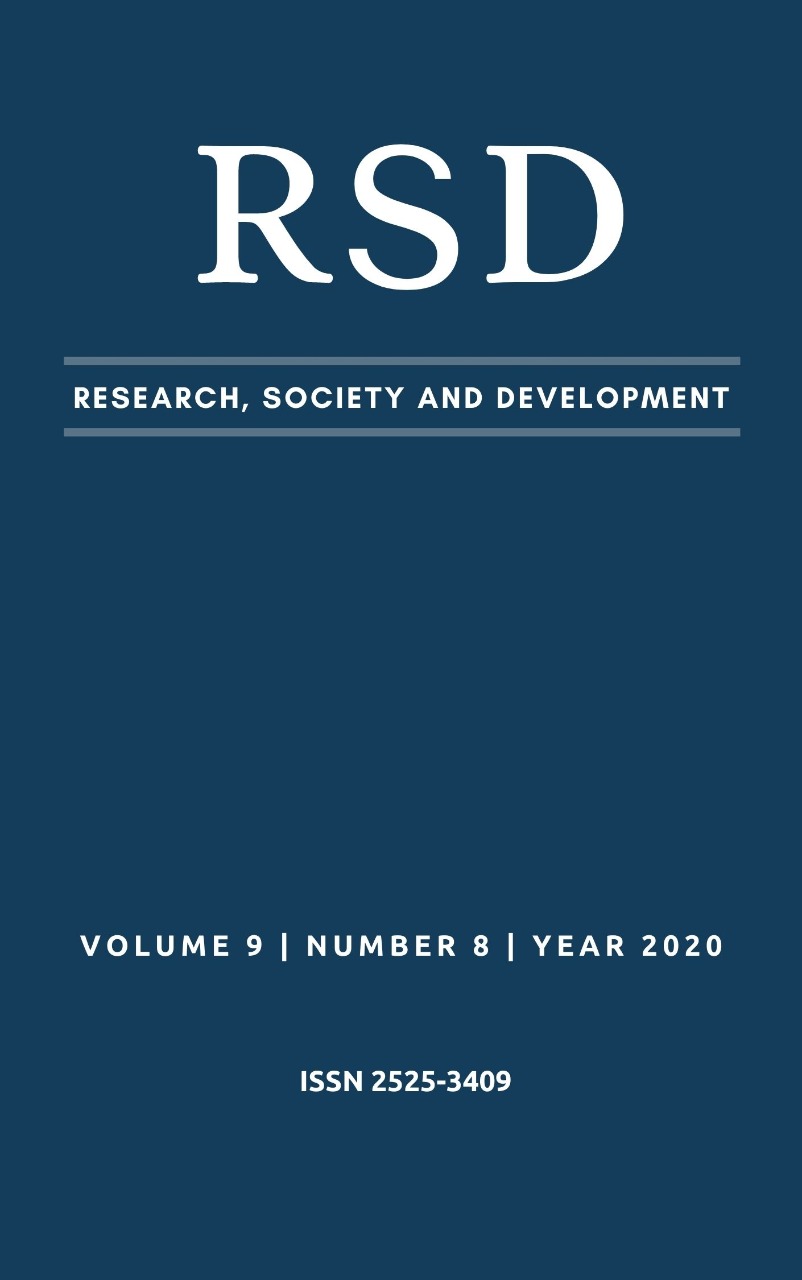Área foliar e índice SPAD do girassol sob irrigação e adubação organomineral
DOI:
https://doi.org/10.33448/rsd-v9i8.5654Palavras-chave:
Helianthus annuus, Déficit hídrico, Fertilizante mineral, Clorofila.Resumo
Objetivou-se no presente estudo, avaliar a área foliar, a Clorofila a, b e total e o índice SPAD do girassol cultivada sob diferentes condições de déficit hídrico e, níveis de adubações com NPK de origem mineral e organomineral. O experimento foi conduzido em vasos plásticos preenchidos com Latossolo Vermelho distroférrico, localizado em área experimental do Instituto Federal Goiano, no município de Rio Verde, Goiás. O delineamento experimental utilizado foi o de blocos ao acaso analisado em esquema fatorial 4×4×2, com três repetições. Os tratamentos foram as combinações de quatro reposições hídricas iguais a 50, 75, 100 e 125% da capacidade de água disponível no solo; quatro doses do formulado de NPK referentes a 50, 100, 150 e 200% da recomendação e duas fontes do formulado NPK, mineral e organomineral. As reposições hídricas foram determinadas através de lisímetros de pesagem eletrônica e a água aplicada via sistema de gotejamento superficial. O número de folhas, a área foliar, a clorofila a, clorofila b, a clorofila total e o índice SPAD foram avaliados aos 20, 40, 60 e 80 dias após a semeadura. A reposição hídrica de 125% proporciona o maior número de folhas e área foliar do girassol cv. Aguará 6. O número de folhas, área foliar e índice SPAD do girassol cv. Aguará 6 é maior quando se utiliza o fertilizante mineral.
Referências
Bernardo, S., Soares, A. A., & Mantovani, E. C. (2009). Manual de Irrigação. Viçosa, Editora UFV, 8ª edição 2ª reimpressão, 625.
Campos, V. B., Chaves, L. H. G., & Guerra, O. C. (2015). Adubação com NPK e irrigação do girassol em Luvissolo: Comportamento vegetativo. Revista Ambiente e Água, 10(1).
Coelho, A. M. (2006). Nutrição e adubação do milho. Circular Técnico 78 Ministério da Agricultura, Pecuária e Abastecimento – EMBRAPA ISSN 1679-1150, Sete Lagoas, MG.
Falker Automação Agrícola Ltda. (2008). Manual do medidor eletrônico de teor clorofla (ClorofLOG / CFL 1030). Porto Alegre: Falker, 33.
Ferreira, D. F. (2011). Sisvar: a computer statistical analysis system. Ciência e Agrotecnologia, 35(6), 1039-1042.
Ferreira, M. M., Ferreira, G. B., Fontes, P. C. R., & Dantas, J. P. (2006). Índice spad e teor de clorofila no limbo foliar do tomateiro em função de doses de nitrogênio e da adubação orgânica, em duas épocas de cultivo. Revista Ceres, 53(305), 83-92.
Furtado, G. de F., Chaves, L. H. G., Souza, L. de P., Sousa Junior, J. R., Lima, G. S., & Sousa, J. R. M. (2017). Índices fisiológicos do girassol em função da adubação com biocarvão e NPK. Revista Brasileira de Agricultura Irrigada, 11(7), 1924-1933.
Köppen, W., & Geiger, R. Klimate der Erde. Gotha: Verlag Justus Perthes. 1928. Wall-map 150cmx200cm.
Leite, L. F. C., Mendonça, E. S., Neves, J. C. L., Machado, P. L. O. A., & Galvão, J. C. C. (2003). Estoques totais de carbono orgânicos e seus compartimentos em argissolo sob floresta e sob milho cultivado com adubação mineral e orgânica. Revista Brasileira Ciência do Solo, 27, 821-832.
Minolta. Camera Co. Ltd., Chlorophyll meter SPAD-502. (1989). Instruction manual. Osaka: Minolta Radiometric Instruments Divisions, 22.
Pereira A. S., et al. (2018). Metodologia da pesquisa científica. [e-book]. Santa Maria. Ed. UAB/NTE/UFSM. Disponível em: https://repositorio.ufsm.br/bitstream/handle/1/15824/Lic_ Computacao_Metodologia-Pesquisa-Cientifica.pdf?sequence=1.
Rabelo, K. C. C. (2015). Fertilizantes organomineral e mineral: aspectos fitotécnicos na cultura do tomate industrial. Dissertação (Mestrado em Agronomia: Solo e Água) – Escola de Agronomia, Universidade Federal de Goiás, 69.
Santos, H. G., Jacomine P. K. T., Anjos, L. H. C., Oliveira, V. A., Lumbreras, J. F., Coelho, M. R., Almeida, J. A., Araújo Filho, J. C., Oliveira, J. B., Cunha, T. J. F. Sistema Brasileiro de Classificação de Solos. Embrapa; Brasília, DF; 5 Ed. rev. amp; 2018.
Santos, J. F., Wanderley, J. A. C., Júnior, J. R. S. (2013). Produção de girassol submetido a adubação organomineral. Agropecuária Cientifica no semiárido, 9(3), 38-44.
Soares, L. A. dos A., Lima, G. S., Chaves, L. H. G., Xavier. D. A., Fernandes, P. D., Gheyi, H. R. (2015). Fitomassa e produção do girassol cultivado sob diferentes níveis de reposição hídrica e adubação potássica. Revista Brasileira de Engenharia Agrícola e Ambiental, 19(4), 336-342.
Sousa, D.M.G., Lobato, E. (2004). Cerrado: Correção do solo e adubação. 2.ed. Brasília, Embrapa Informação Tecnológica, 416.
Taiz, L., Zeiger, E., Moller, I. M., Murphy, A. (2017). Fisiologia e Desenvolvimento Vegetal. 6. ed. Porto Alegre: Artmed.
Winter, E. J. (1984). A água, o solo e a planta: aproveitando os recursos naturais de água para a horticultura. Traduzido pelos professores Klaus Reichardt e Paulo L. Libardi. – 2ª. Ed. – São Paulo: Nobel, 1ª reimpressão, 170.
Downloads
Publicado
Edição
Seção
Licença
Autores que publicam nesta revista concordam com os seguintes termos:
1) Autores mantém os direitos autorais e concedem à revista o direito de primeira publicação, com o trabalho simultaneamente licenciado sob a Licença Creative Commons Attribution que permite o compartilhamento do trabalho com reconhecimento da autoria e publicação inicial nesta revista.
2) Autores têm autorização para assumir contratos adicionais separadamente, para distribuição não-exclusiva da versão do trabalho publicada nesta revista (ex.: publicar em repositório institucional ou como capítulo de livro), com reconhecimento de autoria e publicação inicial nesta revista.
3) Autores têm permissão e são estimulados a publicar e distribuir seu trabalho online (ex.: em repositórios institucionais ou na sua página pessoal) a qualquer ponto antes ou durante o processo editorial, já que isso pode gerar alterações produtivas, bem como aumentar o impacto e a citação do trabalho publicado.


